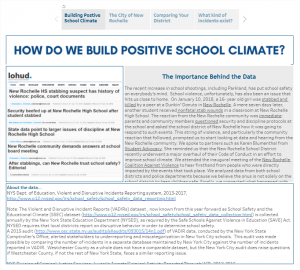The recent increase in school shootings, including Parkland, has put school safety on everybody’s mind. School violence, unfortunately, has also been an issue that hits us close to home. On January 10, 2018, a 16- year old girl was stabbed and killed by a peer at a Dunkin’ Donuts in New Rochelle. A mere seven days later, another student received nonfatal stab wounds in a classroom at New Rochelle High School. The reaction from the New Rochelle community was immediate: parents and community members questioned security and discipline protocols at the school and asked the school district of New Rochelle how it was going to respond to such events.
This string of violence, and particularly the community reaction that followed, prompted us to start looking at data and listening to the New Rochelle community. We spoke to partners such as Karen Blumenthal from Student Advocacy. She reminded us that the New Rochelle School District recently underwent a major overhaul of their Code of Conduct in an effort to improve school climate. We attended the inaugural meeting of the New Rochelle Coalition Against Violence to hear firsthand from people who were directly impacted by the events that took place. We analyzed data from both school districts and police departments because we believe the onus is not solely on the school district to keep children safe. Finally, we connected what happened with one of the outcomes of our GPS4Kids initiative: keeping children in positive learning environments. This blog is coauthored by Denise Killeen, Erica Ayala, and Limarie Cabrera.
The Westchester Children’s Association launched the GPS4Kids Collective Impact initiative in 2015. Since, we have been explicit in our goal to ensure all children in Westchester County thrive regardless of race or zip code. Part of that goal is a focus on healthy communities and positive learning environments. Therefore, when the opportunity to listen and learn from the New Rochelle community presented itself, we embraced it.
Too often data is seen as a tool to criticize, to criminalize or to categorize communities without their input. Therefore, we did not want to only analyze the available data on violent acts in schools and juvenile arrests. We wanted to hear from the community itself; so, we attended the first-ever meeting of the New Rochelle Coalition against Violence. This coalition swiftly formed in the wake of three violent incidents involving New Rochelle High School students in eight days. Members of the New Rochelle community have been, and continue to be, great partners to WCA.
In addition to attending the NRCAV event, we offered an opportunity for GPS4Kids stakeholder Keshia Carter of The Guidance Center of Westchester to reflect on the community-building efforts initiated by New Rochelle youth. Keshia is a College and Career Counselor working very closely with New Rochelle High School students. In her statement for the latest GPS Newsletter, Keshia stated,
“There was an emergency Board of Education meeting at City Hall following the tragic death of a student … there was also another school board meeting at New Rochelle High School the following week where the answers to the questions posed at the city hall meeting where addressed. Here, some current students spoke about the issues at hand, especially when it came to stop and frisk.
One student even organized a session with Stefan Holt of NBC news and some fellow students to speak about how the high school has been in the week after. It was inspiring to see young students take a stand for their community and school. As a community, New Rochelle has to invest in their young people in order for change to take place.”
We hope New Rochelle and the greater Westchester County community uses this post, and the data that goes a long with it, as a guide. There are bound to be concerns, frustrations and calls for action in any community – and especially one grieving from loss. We hope to offer more resources for the community as they map out a road to success and continued growth.
Not Just the Numbers
Traditionally, our blog posts focus heavily on data. In this post (and some other recent posts), we are not only presenting the data but also acknowledging the living community that exists behind the data. This has become a common theme in our work. We no longer want to just publish the numbers; we want to make sure those numbers have a face or a backstory.
A note about the data…
The Violent and Disruptive Incident Reports (VADIRs) dataset , now known from this year forward as School Safety and the Educational Climate (SSEC) dataset http://www.p12.nysed.gov/irs/school_safety/school_safety_data_collection.html) is collected annually by the New York State Education Department (NYSED), as required by the Safe Schools Against Violence in Education (SAVE) Act. NYSED requires that local districts report on disruptive behavior in order to determine school safety.
A 2015 audit (http://www.osc.state.ny.us/audits/allaudits/093015/14n1.pdf) of VADIR data, conducted by the New York State Comptroller’s Office, alerted stakeholders to underreporting and miscategorization in New York City schools. This audit was made possible by comparing the number of incidents in a separate database maintained by New York City against the number of incidents reported in VADIR. Westchester County as a whole does not have a comparable dataset, but the New York City audit does raise questions if Westchester County, if not the rest of New York State, faces a similar reporting issue.



